HI3042 Cross-Cultural Management: Business & Culture Literature Review
VerifiedAdded on 2023/06/14
|8
|2702
|165
Literature Review
AI Summary
This literature review explores the intricate relationship between business and culture, highlighting the significance of organizational behavior in fostering effective social and psychological business environments. It delves into how cultural differences impact global business operations, emphasizing the importance of cross-cultural management and global leadership. The review analyzes the evolution of cross-cultural management research, distinguishing between unicultural, intercultural, and comparative approaches. It further examines the unique dimensions of business culture, including meeting protocols, resource management, and the use of social media. The review also discusses the strengths and weaknesses of organizational culture, emphasizing the role of employee involvement and adaptability in achieving sustainable growth and success. Ultimately, it underscores the necessity of understanding and integrating cultural considerations into business strategies for enhanced organizational performance and competitive advantage. Desklib provides access to similar solved assignments and resources for students.
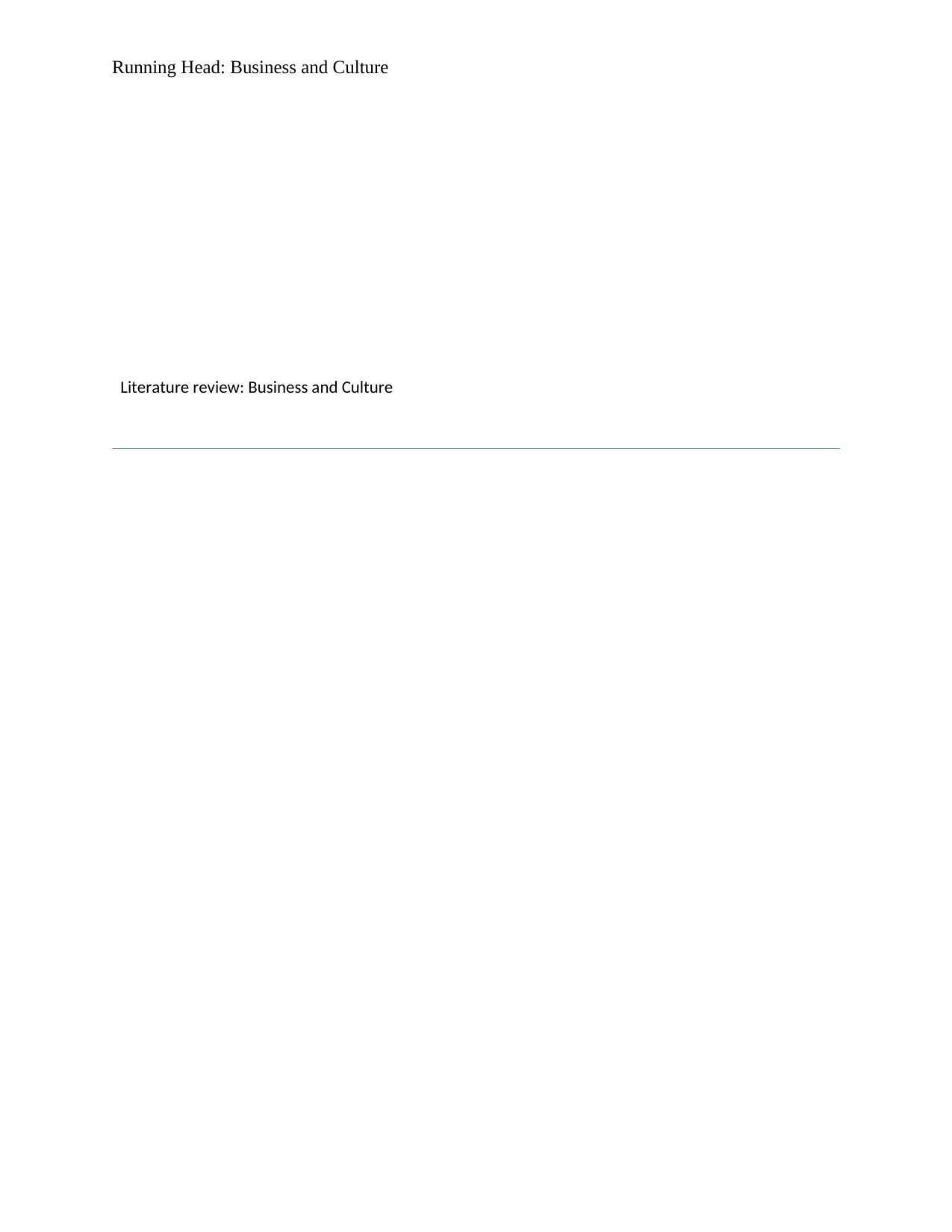
Running Head: Business and Culture
Literature review: Business and Culture
Literature review: Business and Culture
Paraphrase This Document
Need a fresh take? Get an instant paraphrase of this document with our AI Paraphraser
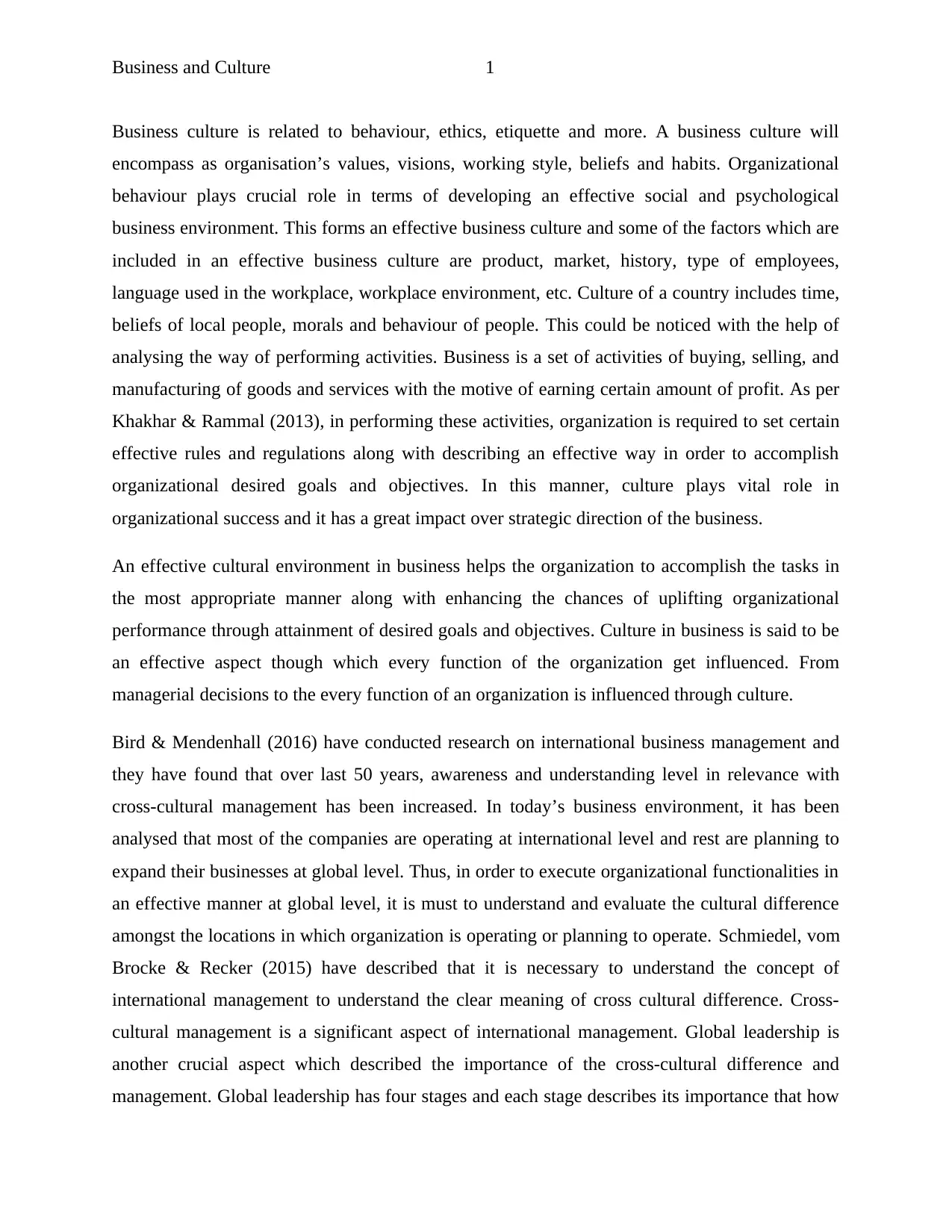
Business and Culture 1
Business culture is related to behaviour, ethics, etiquette and more. A business culture will
encompass as organisation’s values, visions, working style, beliefs and habits. Organizational
behaviour plays crucial role in terms of developing an effective social and psychological
business environment. This forms an effective business culture and some of the factors which are
included in an effective business culture are product, market, history, type of employees,
language used in the workplace, workplace environment, etc. Culture of a country includes time,
beliefs of local people, morals and behaviour of people. This could be noticed with the help of
analysing the way of performing activities. Business is a set of activities of buying, selling, and
manufacturing of goods and services with the motive of earning certain amount of profit. As per
Khakhar & Rammal (2013), in performing these activities, organization is required to set certain
effective rules and regulations along with describing an effective way in order to accomplish
organizational desired goals and objectives. In this manner, culture plays vital role in
organizational success and it has a great impact over strategic direction of the business.
An effective cultural environment in business helps the organization to accomplish the tasks in
the most appropriate manner along with enhancing the chances of uplifting organizational
performance through attainment of desired goals and objectives. Culture in business is said to be
an effective aspect though which every function of the organization get influenced. From
managerial decisions to the every function of an organization is influenced through culture.
Bird & Mendenhall (2016) have conducted research on international business management and
they have found that over last 50 years, awareness and understanding level in relevance with
cross-cultural management has been increased. In today’s business environment, it has been
analysed that most of the companies are operating at international level and rest are planning to
expand their businesses at global level. Thus, in order to execute organizational functionalities in
an effective manner at global level, it is must to understand and evaluate the cultural difference
amongst the locations in which organization is operating or planning to operate. Schmiedel, vom
Brocke & Recker (2015) have described that it is necessary to understand the concept of
international management to understand the clear meaning of cross cultural difference. Cross-
cultural management is a significant aspect of international management. Global leadership is
another crucial aspect which described the importance of the cross-cultural difference and
management. Global leadership has four stages and each stage describes its importance that how
Business culture is related to behaviour, ethics, etiquette and more. A business culture will
encompass as organisation’s values, visions, working style, beliefs and habits. Organizational
behaviour plays crucial role in terms of developing an effective social and psychological
business environment. This forms an effective business culture and some of the factors which are
included in an effective business culture are product, market, history, type of employees,
language used in the workplace, workplace environment, etc. Culture of a country includes time,
beliefs of local people, morals and behaviour of people. This could be noticed with the help of
analysing the way of performing activities. Business is a set of activities of buying, selling, and
manufacturing of goods and services with the motive of earning certain amount of profit. As per
Khakhar & Rammal (2013), in performing these activities, organization is required to set certain
effective rules and regulations along with describing an effective way in order to accomplish
organizational desired goals and objectives. In this manner, culture plays vital role in
organizational success and it has a great impact over strategic direction of the business.
An effective cultural environment in business helps the organization to accomplish the tasks in
the most appropriate manner along with enhancing the chances of uplifting organizational
performance through attainment of desired goals and objectives. Culture in business is said to be
an effective aspect though which every function of the organization get influenced. From
managerial decisions to the every function of an organization is influenced through culture.
Bird & Mendenhall (2016) have conducted research on international business management and
they have found that over last 50 years, awareness and understanding level in relevance with
cross-cultural management has been increased. In today’s business environment, it has been
analysed that most of the companies are operating at international level and rest are planning to
expand their businesses at global level. Thus, in order to execute organizational functionalities in
an effective manner at global level, it is must to understand and evaluate the cultural difference
amongst the locations in which organization is operating or planning to operate. Schmiedel, vom
Brocke & Recker (2015) have described that it is necessary to understand the concept of
international management to understand the clear meaning of cross cultural difference. Cross-
cultural management is a significant aspect of international management. Global leadership is
another crucial aspect which described the importance of the cross-cultural difference and
management. Global leadership has four stages and each stage describes its importance that how
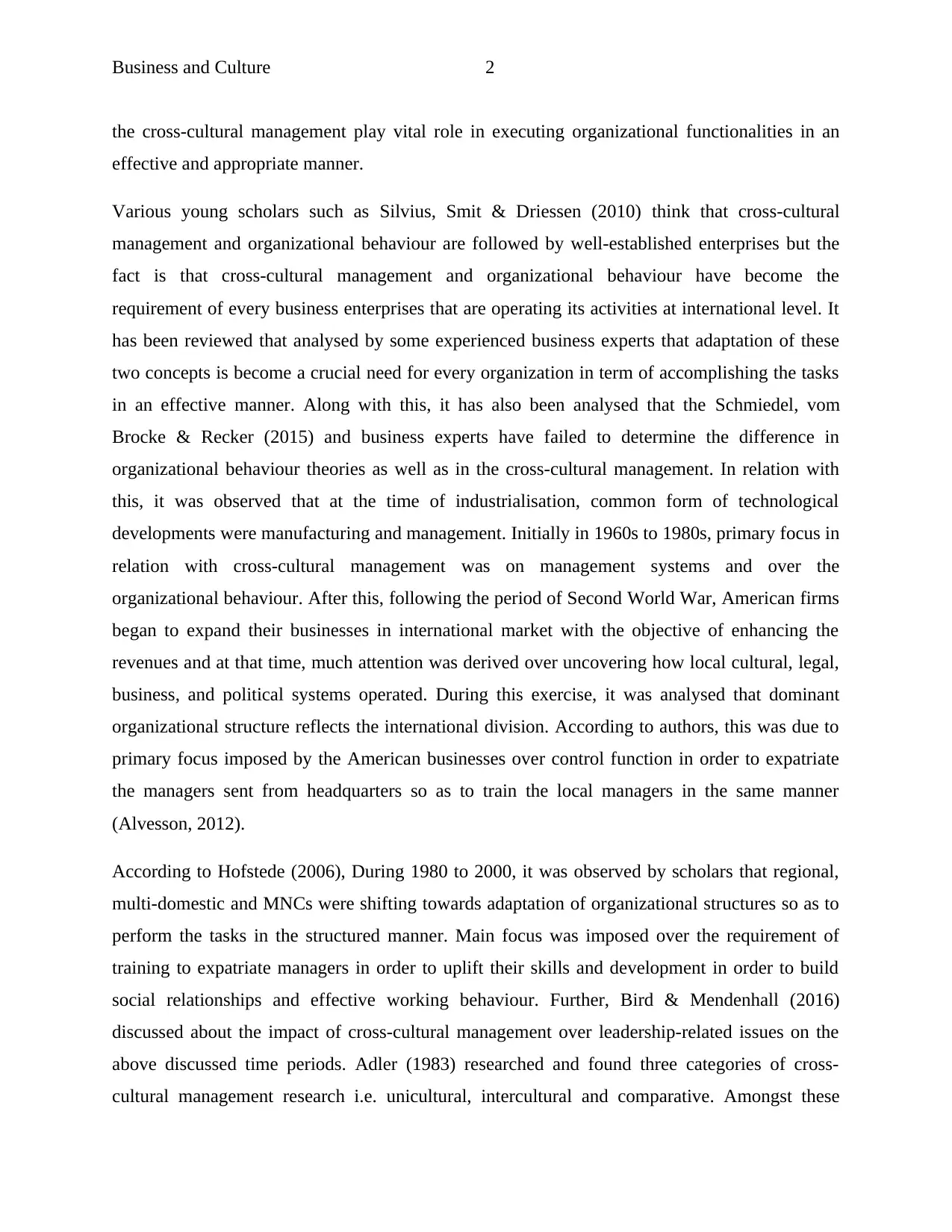
Business and Culture 2
the cross-cultural management play vital role in executing organizational functionalities in an
effective and appropriate manner.
Various young scholars such as Silvius, Smit & Driessen (2010) think that cross-cultural
management and organizational behaviour are followed by well-established enterprises but the
fact is that cross-cultural management and organizational behaviour have become the
requirement of every business enterprises that are operating its activities at international level. It
has been reviewed that analysed by some experienced business experts that adaptation of these
two concepts is become a crucial need for every organization in term of accomplishing the tasks
in an effective manner. Along with this, it has also been analysed that the Schmiedel, vom
Brocke & Recker (2015) and business experts have failed to determine the difference in
organizational behaviour theories as well as in the cross-cultural management. In relation with
this, it was observed that at the time of industrialisation, common form of technological
developments were manufacturing and management. Initially in 1960s to 1980s, primary focus in
relation with cross-cultural management was on management systems and over the
organizational behaviour. After this, following the period of Second World War, American firms
began to expand their businesses in international market with the objective of enhancing the
revenues and at that time, much attention was derived over uncovering how local cultural, legal,
business, and political systems operated. During this exercise, it was analysed that dominant
organizational structure reflects the international division. According to authors, this was due to
primary focus imposed by the American businesses over control function in order to expatriate
the managers sent from headquarters so as to train the local managers in the same manner
(Alvesson, 2012).
According to Hofstede (2006), During 1980 to 2000, it was observed by scholars that regional,
multi-domestic and MNCs were shifting towards adaptation of organizational structures so as to
perform the tasks in the structured manner. Main focus was imposed over the requirement of
training to expatriate managers in order to uplift their skills and development in order to build
social relationships and effective working behaviour. Further, Bird & Mendenhall (2016)
discussed about the impact of cross-cultural management over leadership-related issues on the
above discussed time periods. Adler (1983) researched and found three categories of cross-
cultural management research i.e. unicultural, intercultural and comparative. Amongst these
the cross-cultural management play vital role in executing organizational functionalities in an
effective and appropriate manner.
Various young scholars such as Silvius, Smit & Driessen (2010) think that cross-cultural
management and organizational behaviour are followed by well-established enterprises but the
fact is that cross-cultural management and organizational behaviour have become the
requirement of every business enterprises that are operating its activities at international level. It
has been reviewed that analysed by some experienced business experts that adaptation of these
two concepts is become a crucial need for every organization in term of accomplishing the tasks
in an effective manner. Along with this, it has also been analysed that the Schmiedel, vom
Brocke & Recker (2015) and business experts have failed to determine the difference in
organizational behaviour theories as well as in the cross-cultural management. In relation with
this, it was observed that at the time of industrialisation, common form of technological
developments were manufacturing and management. Initially in 1960s to 1980s, primary focus in
relation with cross-cultural management was on management systems and over the
organizational behaviour. After this, following the period of Second World War, American firms
began to expand their businesses in international market with the objective of enhancing the
revenues and at that time, much attention was derived over uncovering how local cultural, legal,
business, and political systems operated. During this exercise, it was analysed that dominant
organizational structure reflects the international division. According to authors, this was due to
primary focus imposed by the American businesses over control function in order to expatriate
the managers sent from headquarters so as to train the local managers in the same manner
(Alvesson, 2012).
According to Hofstede (2006), During 1980 to 2000, it was observed by scholars that regional,
multi-domestic and MNCs were shifting towards adaptation of organizational structures so as to
perform the tasks in the structured manner. Main focus was imposed over the requirement of
training to expatriate managers in order to uplift their skills and development in order to build
social relationships and effective working behaviour. Further, Bird & Mendenhall (2016)
discussed about the impact of cross-cultural management over leadership-related issues on the
above discussed time periods. Adler (1983) researched and found three categories of cross-
cultural management research i.e. unicultural, intercultural and comparative. Amongst these
⊘ This is a preview!⊘
Do you want full access?
Subscribe today to unlock all pages.

Trusted by 1+ million students worldwide
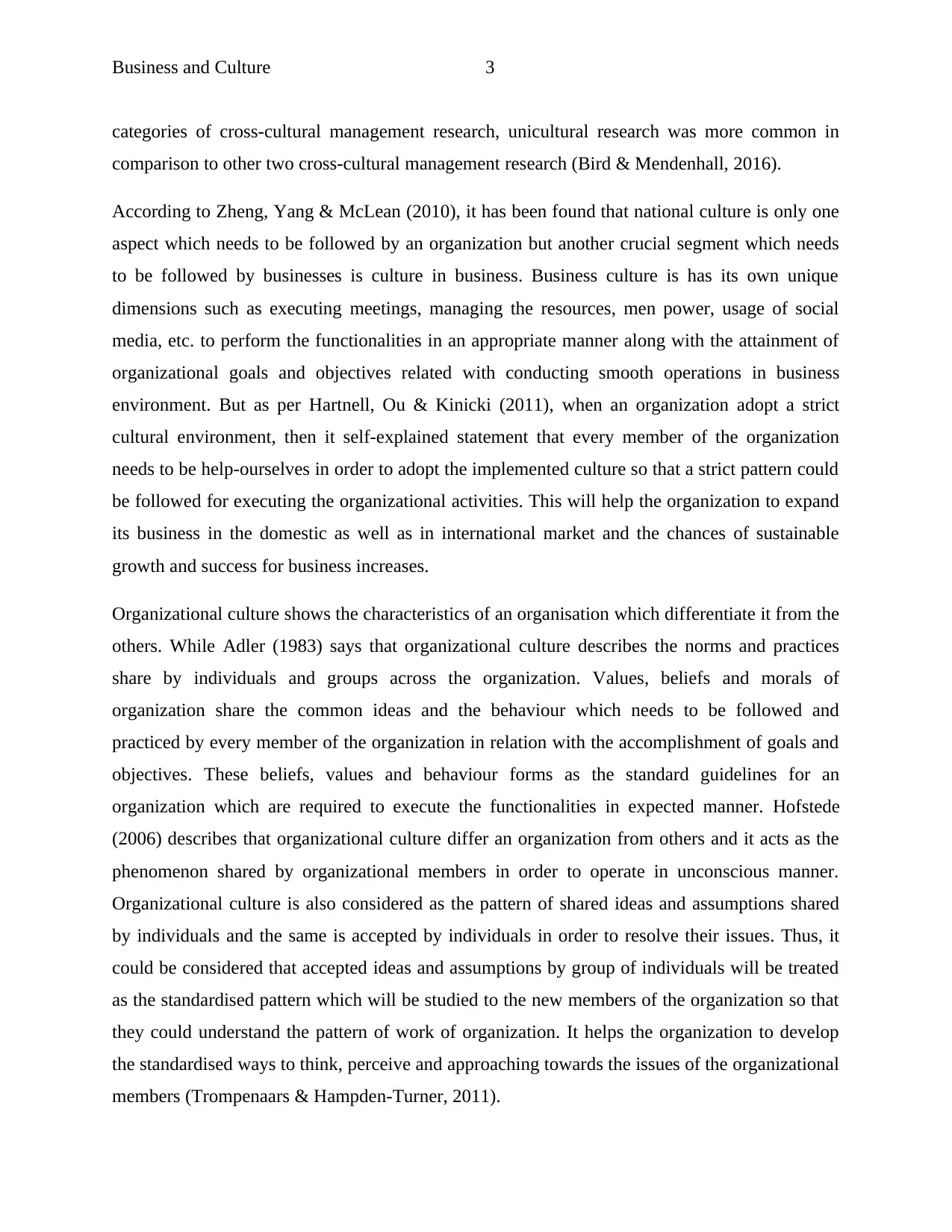
Business and Culture 3
categories of cross-cultural management research, unicultural research was more common in
comparison to other two cross-cultural management research (Bird & Mendenhall, 2016).
According to Zheng, Yang & McLean (2010), it has been found that national culture is only one
aspect which needs to be followed by an organization but another crucial segment which needs
to be followed by businesses is culture in business. Business culture is has its own unique
dimensions such as executing meetings, managing the resources, men power, usage of social
media, etc. to perform the functionalities in an appropriate manner along with the attainment of
organizational goals and objectives related with conducting smooth operations in business
environment. But as per Hartnell, Ou & Kinicki (2011), when an organization adopt a strict
cultural environment, then it self-explained statement that every member of the organization
needs to be help-ourselves in order to adopt the implemented culture so that a strict pattern could
be followed for executing the organizational activities. This will help the organization to expand
its business in the domestic as well as in international market and the chances of sustainable
growth and success for business increases.
Organizational culture shows the characteristics of an organisation which differentiate it from the
others. While Adler (1983) says that organizational culture describes the norms and practices
share by individuals and groups across the organization. Values, beliefs and morals of
organization share the common ideas and the behaviour which needs to be followed and
practiced by every member of the organization in relation with the accomplishment of goals and
objectives. These beliefs, values and behaviour forms as the standard guidelines for an
organization which are required to execute the functionalities in expected manner. Hofstede
(2006) describes that organizational culture differ an organization from others and it acts as the
phenomenon shared by organizational members in order to operate in unconscious manner.
Organizational culture is also considered as the pattern of shared ideas and assumptions shared
by individuals and the same is accepted by individuals in order to resolve their issues. Thus, it
could be considered that accepted ideas and assumptions by group of individuals will be treated
as the standardised pattern which will be studied to the new members of the organization so that
they could understand the pattern of work of organization. It helps the organization to develop
the standardised ways to think, perceive and approaching towards the issues of the organizational
members (Trompenaars & Hampden-Turner, 2011).
categories of cross-cultural management research, unicultural research was more common in
comparison to other two cross-cultural management research (Bird & Mendenhall, 2016).
According to Zheng, Yang & McLean (2010), it has been found that national culture is only one
aspect which needs to be followed by an organization but another crucial segment which needs
to be followed by businesses is culture in business. Business culture is has its own unique
dimensions such as executing meetings, managing the resources, men power, usage of social
media, etc. to perform the functionalities in an appropriate manner along with the attainment of
organizational goals and objectives related with conducting smooth operations in business
environment. But as per Hartnell, Ou & Kinicki (2011), when an organization adopt a strict
cultural environment, then it self-explained statement that every member of the organization
needs to be help-ourselves in order to adopt the implemented culture so that a strict pattern could
be followed for executing the organizational activities. This will help the organization to expand
its business in the domestic as well as in international market and the chances of sustainable
growth and success for business increases.
Organizational culture shows the characteristics of an organisation which differentiate it from the
others. While Adler (1983) says that organizational culture describes the norms and practices
share by individuals and groups across the organization. Values, beliefs and morals of
organization share the common ideas and the behaviour which needs to be followed and
practiced by every member of the organization in relation with the accomplishment of goals and
objectives. These beliefs, values and behaviour forms as the standard guidelines for an
organization which are required to execute the functionalities in expected manner. Hofstede
(2006) describes that organizational culture differ an organization from others and it acts as the
phenomenon shared by organizational members in order to operate in unconscious manner.
Organizational culture is also considered as the pattern of shared ideas and assumptions shared
by individuals and the same is accepted by individuals in order to resolve their issues. Thus, it
could be considered that accepted ideas and assumptions by group of individuals will be treated
as the standardised pattern which will be studied to the new members of the organization so that
they could understand the pattern of work of organization. It helps the organization to develop
the standardised ways to think, perceive and approaching towards the issues of the organizational
members (Trompenaars & Hampden-Turner, 2011).
Paraphrase This Document
Need a fresh take? Get an instant paraphrase of this document with our AI Paraphraser
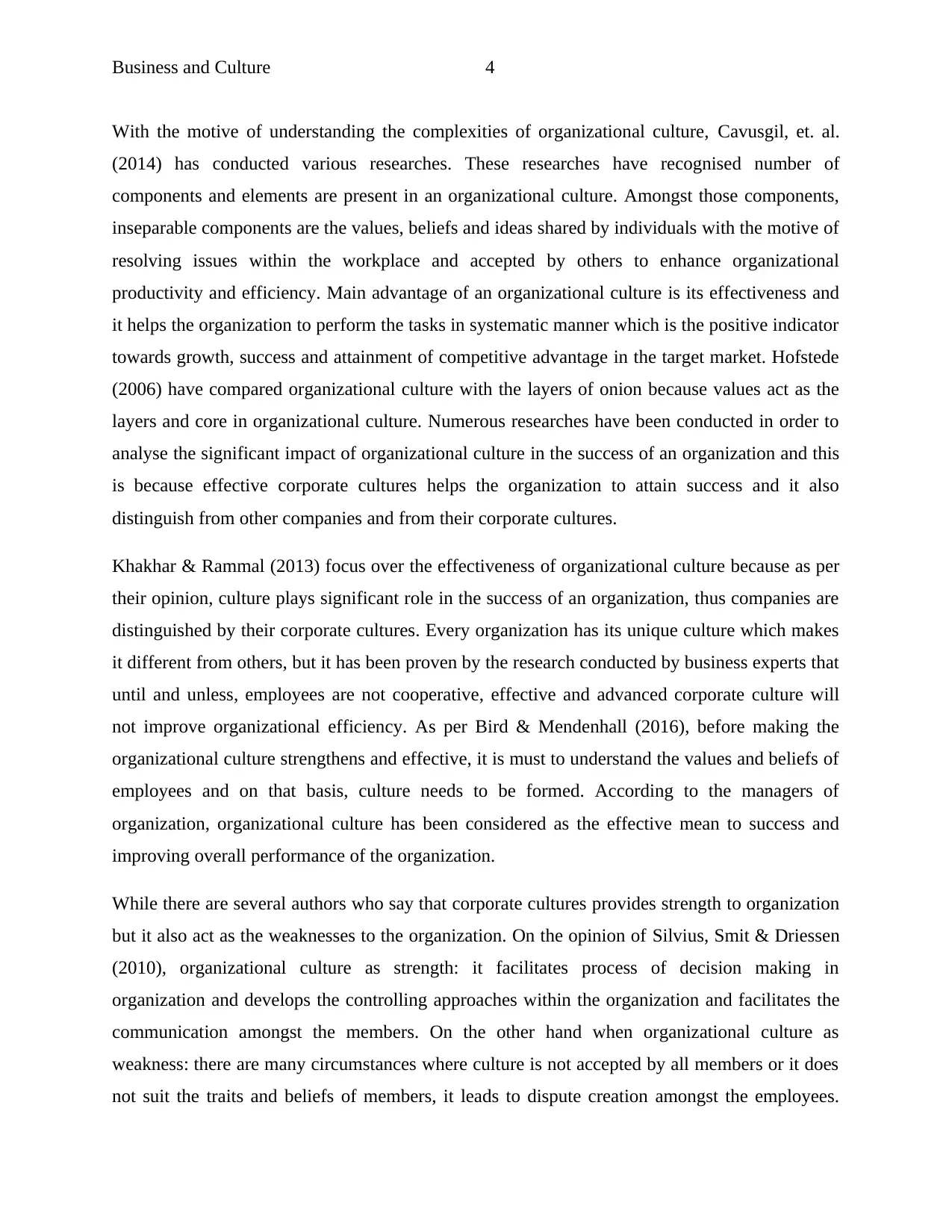
Business and Culture 4
With the motive of understanding the complexities of organizational culture, Cavusgil, et. al.
(2014) has conducted various researches. These researches have recognised number of
components and elements are present in an organizational culture. Amongst those components,
inseparable components are the values, beliefs and ideas shared by individuals with the motive of
resolving issues within the workplace and accepted by others to enhance organizational
productivity and efficiency. Main advantage of an organizational culture is its effectiveness and
it helps the organization to perform the tasks in systematic manner which is the positive indicator
towards growth, success and attainment of competitive advantage in the target market. Hofstede
(2006) have compared organizational culture with the layers of onion because values act as the
layers and core in organizational culture. Numerous researches have been conducted in order to
analyse the significant impact of organizational culture in the success of an organization and this
is because effective corporate cultures helps the organization to attain success and it also
distinguish from other companies and from their corporate cultures.
Khakhar & Rammal (2013) focus over the effectiveness of organizational culture because as per
their opinion, culture plays significant role in the success of an organization, thus companies are
distinguished by their corporate cultures. Every organization has its unique culture which makes
it different from others, but it has been proven by the research conducted by business experts that
until and unless, employees are not cooperative, effective and advanced corporate culture will
not improve organizational efficiency. As per Bird & Mendenhall (2016), before making the
organizational culture strengthens and effective, it is must to understand the values and beliefs of
employees and on that basis, culture needs to be formed. According to the managers of
organization, organizational culture has been considered as the effective mean to success and
improving overall performance of the organization.
While there are several authors who say that corporate cultures provides strength to organization
but it also act as the weaknesses to the organization. On the opinion of Silvius, Smit & Driessen
(2010), organizational culture as strength: it facilitates process of decision making in
organization and develops the controlling approaches within the organization and facilitates the
communication amongst the members. On the other hand when organizational culture as
weakness: there are many circumstances where culture is not accepted by all members or it does
not suit the traits and beliefs of members, it leads to dispute creation amongst the employees.
With the motive of understanding the complexities of organizational culture, Cavusgil, et. al.
(2014) has conducted various researches. These researches have recognised number of
components and elements are present in an organizational culture. Amongst those components,
inseparable components are the values, beliefs and ideas shared by individuals with the motive of
resolving issues within the workplace and accepted by others to enhance organizational
productivity and efficiency. Main advantage of an organizational culture is its effectiveness and
it helps the organization to perform the tasks in systematic manner which is the positive indicator
towards growth, success and attainment of competitive advantage in the target market. Hofstede
(2006) have compared organizational culture with the layers of onion because values act as the
layers and core in organizational culture. Numerous researches have been conducted in order to
analyse the significant impact of organizational culture in the success of an organization and this
is because effective corporate cultures helps the organization to attain success and it also
distinguish from other companies and from their corporate cultures.
Khakhar & Rammal (2013) focus over the effectiveness of organizational culture because as per
their opinion, culture plays significant role in the success of an organization, thus companies are
distinguished by their corporate cultures. Every organization has its unique culture which makes
it different from others, but it has been proven by the research conducted by business experts that
until and unless, employees are not cooperative, effective and advanced corporate culture will
not improve organizational efficiency. As per Bird & Mendenhall (2016), before making the
organizational culture strengthens and effective, it is must to understand the values and beliefs of
employees and on that basis, culture needs to be formed. According to the managers of
organization, organizational culture has been considered as the effective mean to success and
improving overall performance of the organization.
While there are several authors who say that corporate cultures provides strength to organization
but it also act as the weaknesses to the organization. On the opinion of Silvius, Smit & Driessen
(2010), organizational culture as strength: it facilitates process of decision making in
organization and develops the controlling approaches within the organization and facilitates the
communication amongst the members. On the other hand when organizational culture as
weakness: there are many circumstances where culture is not accepted by all members or it does
not suit the traits and beliefs of members, it leads to dispute creation amongst the employees.
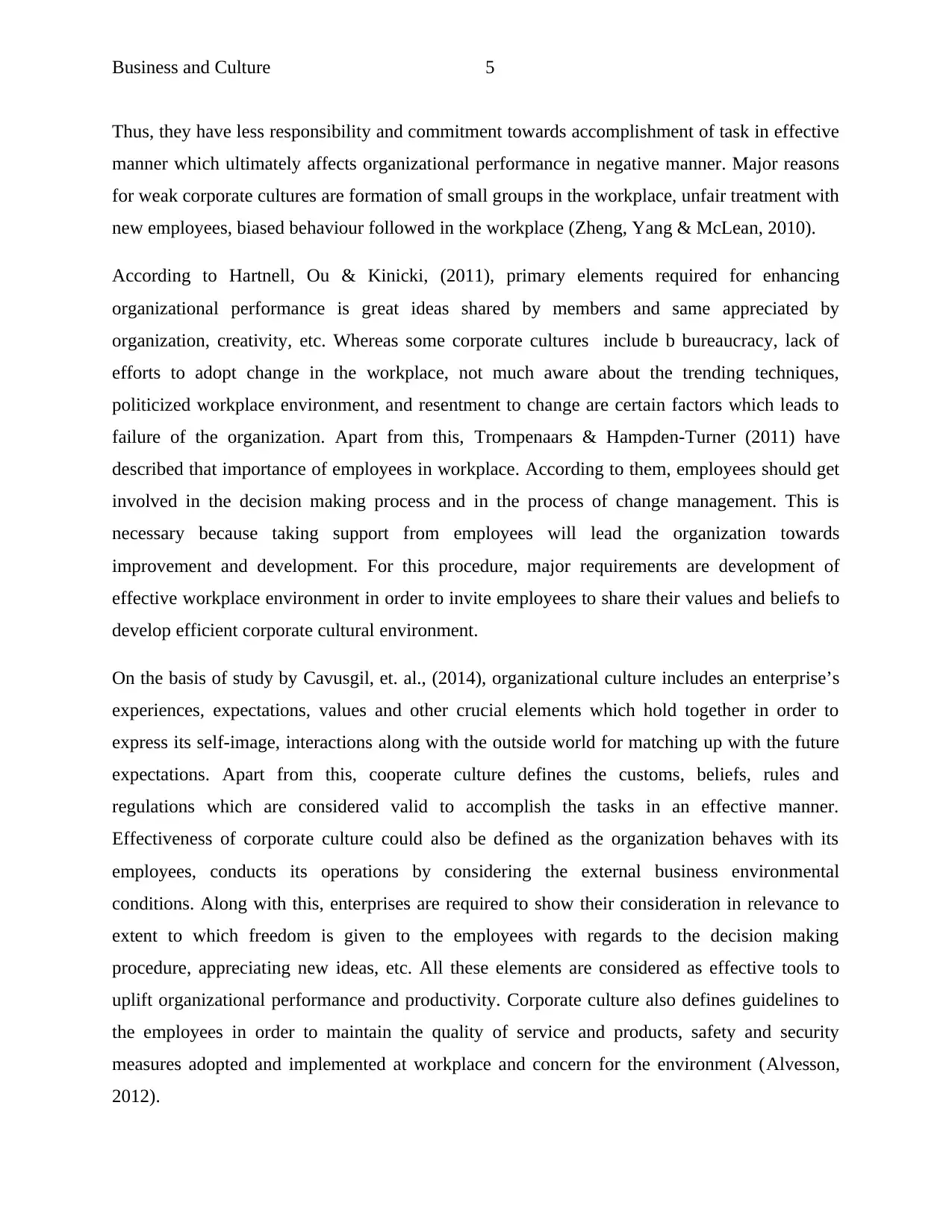
Business and Culture 5
Thus, they have less responsibility and commitment towards accomplishment of task in effective
manner which ultimately affects organizational performance in negative manner. Major reasons
for weak corporate cultures are formation of small groups in the workplace, unfair treatment with
new employees, biased behaviour followed in the workplace (Zheng, Yang & McLean, 2010).
According to Hartnell, Ou & Kinicki, (2011), primary elements required for enhancing
organizational performance is great ideas shared by members and same appreciated by
organization, creativity, etc. Whereas some corporate cultures include b bureaucracy, lack of
efforts to adopt change in the workplace, not much aware about the trending techniques,
politicized workplace environment, and resentment to change are certain factors which leads to
failure of the organization. Apart from this, Trompenaars & Hampden-Turner (2011) have
described that importance of employees in workplace. According to them, employees should get
involved in the decision making process and in the process of change management. This is
necessary because taking support from employees will lead the organization towards
improvement and development. For this procedure, major requirements are development of
effective workplace environment in order to invite employees to share their values and beliefs to
develop efficient corporate cultural environment.
On the basis of study by Cavusgil, et. al., (2014), organizational culture includes an enterprise’s
experiences, expectations, values and other crucial elements which hold together in order to
express its self-image, interactions along with the outside world for matching up with the future
expectations. Apart from this, cooperate culture defines the customs, beliefs, rules and
regulations which are considered valid to accomplish the tasks in an effective manner.
Effectiveness of corporate culture could also be defined as the organization behaves with its
employees, conducts its operations by considering the external business environmental
conditions. Along with this, enterprises are required to show their consideration in relevance to
extent to which freedom is given to the employees with regards to the decision making
procedure, appreciating new ideas, etc. All these elements are considered as effective tools to
uplift organizational performance and productivity. Corporate culture also defines guidelines to
the employees in order to maintain the quality of service and products, safety and security
measures adopted and implemented at workplace and concern for the environment (Alvesson,
2012).
Thus, they have less responsibility and commitment towards accomplishment of task in effective
manner which ultimately affects organizational performance in negative manner. Major reasons
for weak corporate cultures are formation of small groups in the workplace, unfair treatment with
new employees, biased behaviour followed in the workplace (Zheng, Yang & McLean, 2010).
According to Hartnell, Ou & Kinicki, (2011), primary elements required for enhancing
organizational performance is great ideas shared by members and same appreciated by
organization, creativity, etc. Whereas some corporate cultures include b bureaucracy, lack of
efforts to adopt change in the workplace, not much aware about the trending techniques,
politicized workplace environment, and resentment to change are certain factors which leads to
failure of the organization. Apart from this, Trompenaars & Hampden-Turner (2011) have
described that importance of employees in workplace. According to them, employees should get
involved in the decision making process and in the process of change management. This is
necessary because taking support from employees will lead the organization towards
improvement and development. For this procedure, major requirements are development of
effective workplace environment in order to invite employees to share their values and beliefs to
develop efficient corporate cultural environment.
On the basis of study by Cavusgil, et. al., (2014), organizational culture includes an enterprise’s
experiences, expectations, values and other crucial elements which hold together in order to
express its self-image, interactions along with the outside world for matching up with the future
expectations. Apart from this, cooperate culture defines the customs, beliefs, rules and
regulations which are considered valid to accomplish the tasks in an effective manner.
Effectiveness of corporate culture could also be defined as the organization behaves with its
employees, conducts its operations by considering the external business environmental
conditions. Along with this, enterprises are required to show their consideration in relevance to
extent to which freedom is given to the employees with regards to the decision making
procedure, appreciating new ideas, etc. All these elements are considered as effective tools to
uplift organizational performance and productivity. Corporate culture also defines guidelines to
the employees in order to maintain the quality of service and products, safety and security
measures adopted and implemented at workplace and concern for the environment (Alvesson,
2012).
⊘ This is a preview!⊘
Do you want full access?
Subscribe today to unlock all pages.

Trusted by 1+ million students worldwide
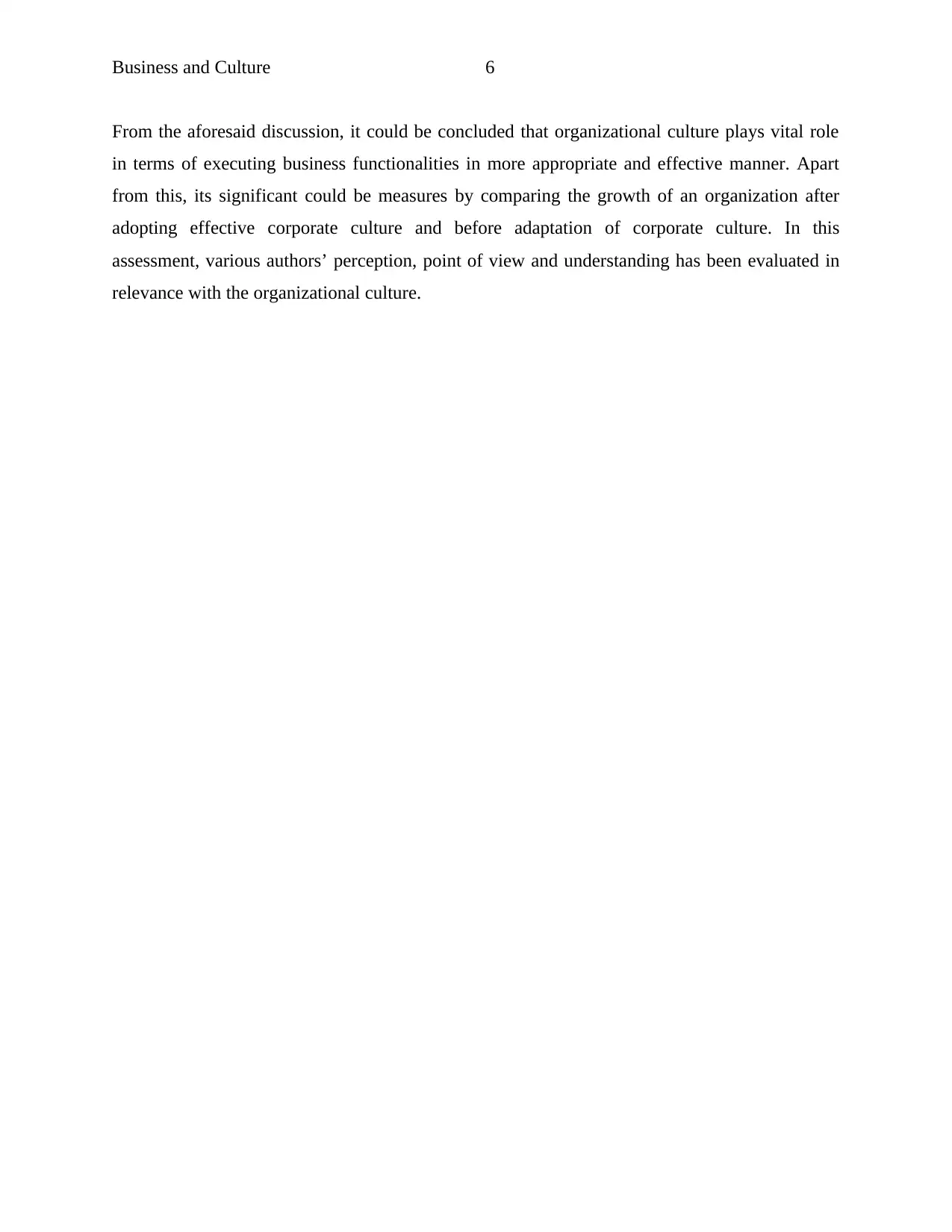
Business and Culture 6
From the aforesaid discussion, it could be concluded that organizational culture plays vital role
in terms of executing business functionalities in more appropriate and effective manner. Apart
from this, its significant could be measures by comparing the growth of an organization after
adopting effective corporate culture and before adaptation of corporate culture. In this
assessment, various authors’ perception, point of view and understanding has been evaluated in
relevance with the organizational culture.
From the aforesaid discussion, it could be concluded that organizational culture plays vital role
in terms of executing business functionalities in more appropriate and effective manner. Apart
from this, its significant could be measures by comparing the growth of an organization after
adopting effective corporate culture and before adaptation of corporate culture. In this
assessment, various authors’ perception, point of view and understanding has been evaluated in
relevance with the organizational culture.
Paraphrase This Document
Need a fresh take? Get an instant paraphrase of this document with our AI Paraphraser
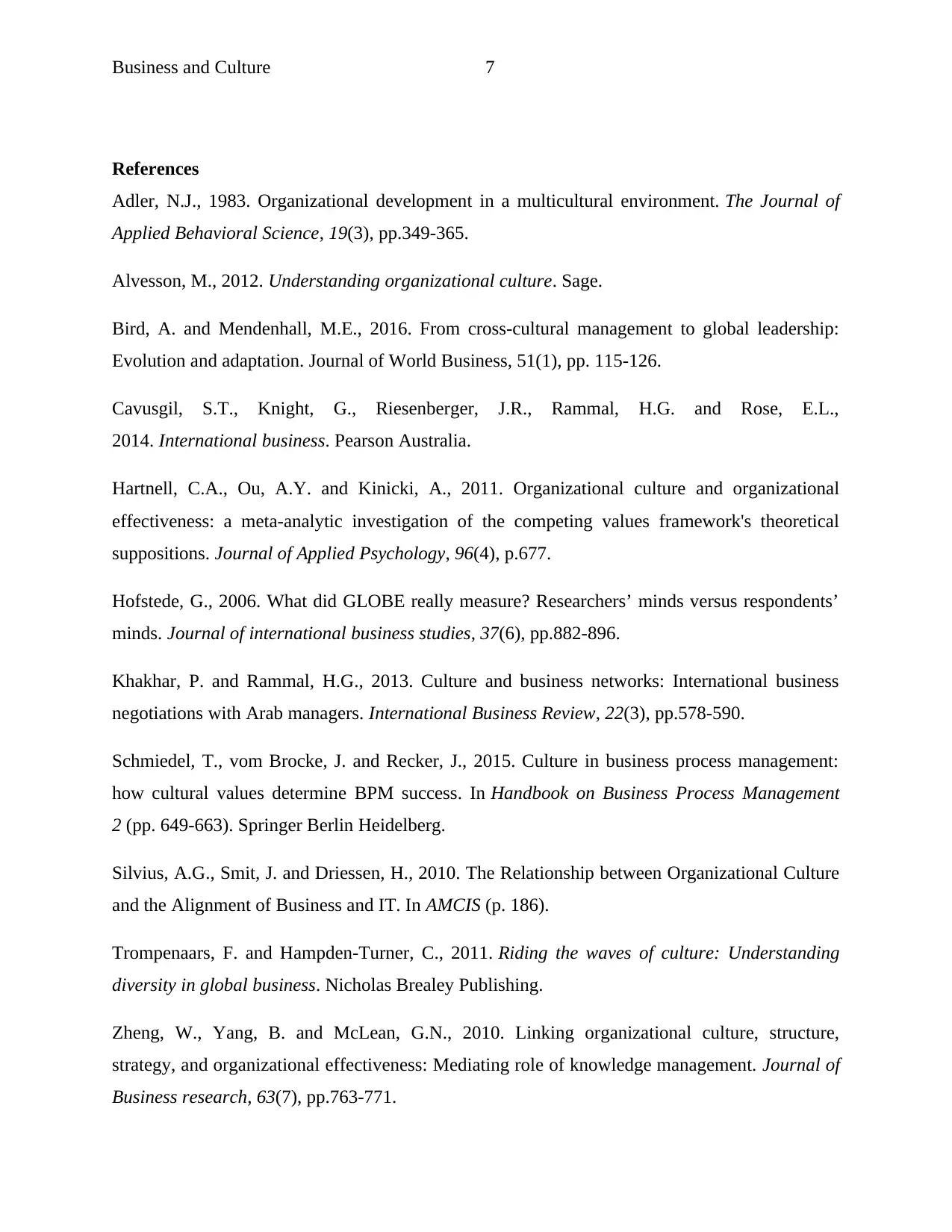
Business and Culture 7
References
Adler, N.J., 1983. Organizational development in a multicultural environment. The Journal of
Applied Behavioral Science, 19(3), pp.349-365.
Alvesson, M., 2012. Understanding organizational culture. Sage.
Bird, A. and Mendenhall, M.E., 2016. From cross-cultural management to global leadership:
Evolution and adaptation. Journal of World Business, 51(1), pp. 115-126.
Cavusgil, S.T., Knight, G., Riesenberger, J.R., Rammal, H.G. and Rose, E.L.,
2014. International business. Pearson Australia.
Hartnell, C.A., Ou, A.Y. and Kinicki, A., 2011. Organizational culture and organizational
effectiveness: a meta-analytic investigation of the competing values framework's theoretical
suppositions. Journal of Applied Psychology, 96(4), p.677.
Hofstede, G., 2006. What did GLOBE really measure? Researchers’ minds versus respondents’
minds. Journal of international business studies, 37(6), pp.882-896.
Khakhar, P. and Rammal, H.G., 2013. Culture and business networks: International business
negotiations with Arab managers. International Business Review, 22(3), pp.578-590.
Schmiedel, T., vom Brocke, J. and Recker, J., 2015. Culture in business process management:
how cultural values determine BPM success. In Handbook on Business Process Management
2 (pp. 649-663). Springer Berlin Heidelberg.
Silvius, A.G., Smit, J. and Driessen, H., 2010. The Relationship between Organizational Culture
and the Alignment of Business and IT. In AMCIS (p. 186).
Trompenaars, F. and Hampden-Turner, C., 2011. Riding the waves of culture: Understanding
diversity in global business. Nicholas Brealey Publishing.
Zheng, W., Yang, B. and McLean, G.N., 2010. Linking organizational culture, structure,
strategy, and organizational effectiveness: Mediating role of knowledge management. Journal of
Business research, 63(7), pp.763-771.
References
Adler, N.J., 1983. Organizational development in a multicultural environment. The Journal of
Applied Behavioral Science, 19(3), pp.349-365.
Alvesson, M., 2012. Understanding organizational culture. Sage.
Bird, A. and Mendenhall, M.E., 2016. From cross-cultural management to global leadership:
Evolution and adaptation. Journal of World Business, 51(1), pp. 115-126.
Cavusgil, S.T., Knight, G., Riesenberger, J.R., Rammal, H.G. and Rose, E.L.,
2014. International business. Pearson Australia.
Hartnell, C.A., Ou, A.Y. and Kinicki, A., 2011. Organizational culture and organizational
effectiveness: a meta-analytic investigation of the competing values framework's theoretical
suppositions. Journal of Applied Psychology, 96(4), p.677.
Hofstede, G., 2006. What did GLOBE really measure? Researchers’ minds versus respondents’
minds. Journal of international business studies, 37(6), pp.882-896.
Khakhar, P. and Rammal, H.G., 2013. Culture and business networks: International business
negotiations with Arab managers. International Business Review, 22(3), pp.578-590.
Schmiedel, T., vom Brocke, J. and Recker, J., 2015. Culture in business process management:
how cultural values determine BPM success. In Handbook on Business Process Management
2 (pp. 649-663). Springer Berlin Heidelberg.
Silvius, A.G., Smit, J. and Driessen, H., 2010. The Relationship between Organizational Culture
and the Alignment of Business and IT. In AMCIS (p. 186).
Trompenaars, F. and Hampden-Turner, C., 2011. Riding the waves of culture: Understanding
diversity in global business. Nicholas Brealey Publishing.
Zheng, W., Yang, B. and McLean, G.N., 2010. Linking organizational culture, structure,
strategy, and organizational effectiveness: Mediating role of knowledge management. Journal of
Business research, 63(7), pp.763-771.
1 out of 8
Related Documents
Your All-in-One AI-Powered Toolkit for Academic Success.
+13062052269
info@desklib.com
Available 24*7 on WhatsApp / Email
![[object Object]](/_next/static/media/star-bottom.7253800d.svg)
Unlock your academic potential
Copyright © 2020–2025 A2Z Services. All Rights Reserved. Developed and managed by ZUCOL.




